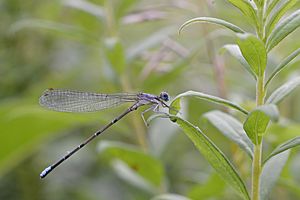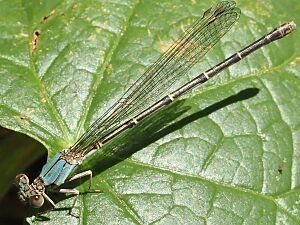Blue-fronted dancer facts for kids
Quick facts for kids Blue-fronted dancer |
|
|---|---|
 |
|
| Male | |
 |
|
| Female | |
| Conservation status | |
| Scientific classification |
The blue-fronted dancer (Argia apicalis) is a type of damselfly found in North America. It belongs to the Coenagrionidae family. This damselfly was first officially described by an American scientist named Thomas Say in 1840. It's a very common species, living in many different places. Because there are so many of them, experts say it's a species of "least concern", meaning it's not currently in danger.
Contents
What Does the Blue-Fronted Dancer Look Like?
These damselflies are usually about 33 to 40 mm (1.3 to 1.6 in) long. That's about the length of a paperclip!
Male Blue-Fronted Dancers
Most male blue-fronted dancers have a blue body section called the thorax. This part has a few thin black lines. Their tail, or abdomen, also has bright blue tips on the last three segments. The rest of their abdomen is dark brown.
However, not all males are blue. Some can be grayish-black instead. What's cool is that they can change their color! A male might be blue one day and grayish-black a few days later. This color change doesn't seem to be linked to how old they are.
Female Blue-Fronted Dancers
Female blue-fronted dancers also have different colors on their thorax. They can be brown, turquoise, or grayish-black. Like the males, their color can change over time. These changes also don't seem to be related to their age.
Where Do Blue-Fronted Dancers Live?
The blue-fronted dancer lives across a large part of North America. You can find them from Ontario in Canada, all the way through most of the United States, and down to the state of Nuevo León in Mexico.
They like many different watery places. This includes big and small rivers, streams, lakes, and ponds. They are most often found near large, muddy rivers. Even though they often live in wooded areas, you can also spot them in places without many trees.
How Do Blue-Fronted Dancers Behave?
Adult blue-fronted dancers are active from mid-summer onwards.
Mating and Egg-Laying
Male damselflies often fly around small areas over the water. Females usually only come to the water when they are ready to mate. When a female arrives, mating happens quickly, with no special dances or courtship.
After mating, the male and female fly together, looking for good spots to lay eggs. The female starts laying eggs while still connected to the male. She often keeps laying eggs even after the male has flown away. They lay their eggs in places like willow roots, floating wood, or on horizontal plant stems. At this point, the male isn't aggressive towards other males. Several females might even use the same spots to lay their eggs.
Daily Life of a Damselfly
Scientists have studied these damselflies a lot. Their behavior is typical for many damselfly species. In one study in Oklahoma, adult damselflies appeared throughout the summer.
Males spent about 40% of their adult days near water. Females spent less time, only about 20% of their days near water. The rest of the time, both sexes were usually in nearby woods.
Males arrived at the water earlier in the day than females. They would patrol areas, staying about 2 meters (6 feet) away from other males. If another damselfly entered their space, they would quickly dart at them to scare them off. They usually succeeded without actually touching. The busiest time for them was around midday.
When a female entered a male's territory, they would mate right away. After mating, the pair would explore the pond for about 25 minutes. Then, they would spend about an hour laying eggs together. The female would continue laying eggs alone for another 20 minutes. After laying eggs, females would quickly fly away.
Scientists found that marked males lived for about 8 days on average, and females lived for about 7 days. However, the oldest male they tracked lived for 33 days! By late afternoon, all the damselflies would leave the water.
Images for kids




